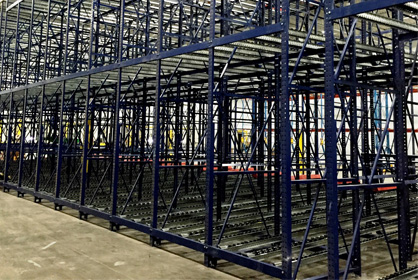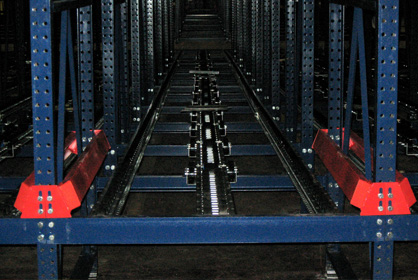The World's Best Storage Rack
Ingenuity • Quality • Integrity
Pallet Flow Racking

The Flow of Efficiency: The Advantages of Pallet Flow Racking
Efficiency in warehousing and storage can make or break a business's success. Pallet Flow Racking is transforming how businesses manage their inventory, offering a unique set of advantages. Let's delve into the benefits that make this racking system a game-changer for modern warehouses.
Pallet flow racking systems share a lot of the same mechanics as push-back racking systems, largely in that their motion is achieved by sloping a rail to propel pallets in a certain direction. In terms of density, pallet flow is comparable to both push-back and drive-in/drive-thru rack but falls between the two in functionality. Pallet flow rack is less limited in achieving larger depths than push-back systems that rely on individual carts for each palletized load but require greater evaluation of the structural integrity of the pallets themselves. Very deep systems are also recommended to be styled more similarly to drive-in/drive-thru systems, with only a single pallet width per bay.
- High-Density Storage: Pallet Flow Racking is all about maximizing storage density. It's designed to make the most of available space by allowing for deep storage of multiple pallets on a first-in, first-out (FIFO) basis. This high-density approach significantly increases your storage capacity.
- Efficient Space Utilization: Effective use of both horizontal and vertical space is critical for any warehouse operation. Pallet Flow Racking excels at this, making it ideal for businesses with a large number of pallets with the same SKU or perishable goods.
- Optimal Stock Rotation: With Pallet Flow Racking's FIFO system, stock rotation becomes a breeze. Older stock is naturally pushed to the front and picked first, reducing the risk of product spoilage or obsolescence.
- Streamlined Handling: Pallet Flow Racking minimizes the need for forklift operators to enter the rack system. Pallets move forward under gravity, allowing for efficient and safe picking and restocking. This reduces the risk of accidents and speeds up operations.
- Selective Accessibility: Despite its high-density design, Pallet Flow Racking offers selective access to each pallet. This means you can efficiently manage your inventory by accessing individual pallets when needed, without disturbing others.
- Adaptability: These racking systems are highly adaptable and can be customized to meet your specific requirements. Whether you need configurations for varying pallet sizes, different product weights, or unique storage needs, Pallet Flow Racking can be tailored to suit your inventory perfectly.
- Cost-Efficient Solution: The initial investment in Pallet Flow Racking often proves cost-effective due to the improved storage efficiency and reduced labor costs it brings. It allows for efficient inventory control, reducing the risk of stockouts or overstocking.
- Enhanced Safety: Safety is paramount in any warehouse operation. Pallet Flow Racking systems come with safety features like speed controllers and braking systems, ensuring a controlled flow of pallets and reducing the risk of accidents.
- Low Maintenance: These racking systems are known for their durability and low maintenance requirements. This means fewer disruptions due to repairs and more uptime for your warehouse operations.
Pallet Flow Racking offers a winning combination of high-density storage, efficient space utilization, optimal stock rotation, adaptability, and cost-efficiency. Whether you operate a distribution center, manufacturing facility, or retail operation, this racking system can optimize your storage space, enhance inventory control, and elevate overall operational efficiency.
Pallet Flow as Push-Back Pallet Racking
Pallet flow rack systems can also be used with the intention of only accessing pallets from a single end. This configuration negates needing an extra aisle at the rear of the system as fork trucks can simply push the pallets back and up the slope. By utilizing pallet flow as push-back rack, system depths can exceed what is feasible by telescoping carts and can be installed with the rear of the system close to a wall. This not only factors in increased storage density but also decreases the footprint required to use the system.

Pallet Condition & RBI Storage Solutions
For pallet flow systems, pallet condition is a highly important aspect of design that should always be evaluated extensively. Poor condition pallets can result in less than desirable performance or outright failure if not evaluated carefully. However, RBI can provide a wide range of solutions that can be used:
For pallets with excellent to good quality, two pallet flow rails per pallet lane becomes an option. The wheels or rollers can be singular or staggered for variances in SKU sizes.
For pallets with fair quality or in cases of heavy loads, a center roller lane can be added to spread out the load bearing of each pallet.
For poor quality pallets or large variances in SKU sizes, full width pallet flow rollers can be provided.
Several different types of accessories can also be added to tailor a pallet flow system to each individual client’s demands. These range from guidance devices that can be installed throughout the depth of a system to keep lanes separate or at the entry points of the system to help with loading, to braking systems that provide a more controlled flow particularly in very deep systems.
The Rack Builder Difference:
RBI’s pallet flow racking systems utilize a combination of sloped beams and a depth-spanning roller system. There is a wide variety in flow track types designed to meet nearly every application of pallet racking storage; from heavy, poor-conditioned palletized loads to many SKUs pallet flow offers the most ‘coverage’. Fork trucks interact with pallet flow systems exclusively at the front and rear – allowing for the system to be loaded as a selective pallet rack system would be. The fork truck will approach the higher end of the system and deposit the pallet. Once the load leaves the forks it will slide through the depth of the system and arrive in the next available pallet location. This design makes pallet flow very helpful not only for storage but for facility flow-through in the warehouse itself.
Ready to explore the potential of Pallet Flow Racking for your warehouse? Contact us today to discuss your storage needs and discover how this system can transform your storage space.

